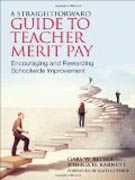
Finally, a guide that cuts through the politics to focus on the nuts and bolts If you are considering using merit pay, this book is for you. This how-to guide lays out the steps from start to finish for creating a successful merit pay program. The authors draw on their extensive experience working with states, districts, and schools to provide: - Detailed charts, tables, and figures to give you an inside look at four existing merit pay programs - A review of what successful programs should include and the pitfalls to avoid - Clear steps for developing a merit pay system in your own school or district INDICE: ForewordPrefaceAcknowledgmentsAbout the Authors1. Introduction: Merit Pay as Educational Fad or Genuine Solution What Is Merit Pay? Why the Interest in Merit Pay? What’s Wrong with the Current Salary System? How Might Merit Pay Help? Why is Merit Pay So Complicated?2. Why Is Merit Pay Gaining Momentum? A Brief History3. What Can a Merit Plan Do for Your Teachers and Students? Evidence on Merit Pay Studies on Teacher Attitudes Studies on Student Achievement Summary of Evidence4. The Top 12 Criticisms of Merit Pay 1. Merit Pay Discourages Teaching Disadvantaged Students 2. Merit Pay Encourages Teaching to the Test 3. What About Teachers of Nontested Subjects? 4. Merit Pay Assumes Teachers Teach for the Money; They Don't! 5. Teacher Merit Is Just Too Hard to Measure 6. Merit Pay Ratings Are Based on a Secret Formula 7. Teachers Are Already Working as Hard as They Can 8. Merit Pay Bonuses Are Too Small to Matter 9. How Is Measuring Teacher Effectiveness Supposed to Improve Instruction? 10. Merit Pay Encourages Counterproductive Competition and Discourages Collegiality 11. States Can't Afford Merit Pay During Times of Fiscal Austerity 12. Merit Pay Is an Unproven Reform5. Guiding Principles and Pesky Questions Guiding Principles for Designing and Implementing a Merit Pay Plan Principle 1: The Evaluation System Must Be Clear and Understandable Principle 2: Consistent Communication Is Critical Principle 3: Evaluations Should Be Based on Multiple and Thoughtful Measures of Effectiveness Principle 4: Plans Should Actively Encourage Collaboration and Discourage Counterproductive Competition Principle 5: Merit Pay Plans Should Be Part of a Comprehensive School Improvement Strategy Principle 6: Merit Pay Bonuses Should Be Substantial and Meaningful Pesky Questions Identifying Program Participants Measuring Teacher Effectiveness Ratings and Rewards6. Timelines for Program Development and Implementation Program Implementation Timeline Step 1: Mulling It Over Step 2: Organizing a Merit Pay Exploratory Committee Step 3: First Meeting With the Exploratory Committee Step 4: Introducing the Concept to the Full School Community Step 5: Details, Details, Details Step 6: Finalizing and Ratifying the Plan, or Rocking the Vote Step 7: Getting Ready to Roll Out the Plan Step 8: Gentlemen, Start Your Engines Step 9: Checking In Step 10: Show Me the Money7. RAMP: Ramping Up Teacher Pay in Your School RAMP: General Overview RAMP: Details Supervisor Evaluation Schoolwide Student Achievement Individual Classroom Achievement Translating the Ratings Into Dollars Closing8. Conclusions Finding Funding Expectations for Your Program Closing Appendix A: Sample Teacher Survey Appendix B: Project on Incentives in Teaching (POINT) Teacher Survey Appendix C: Sample Report CardReferencesIndex RAMP: Applying the Principles
- ISBN: 978-1-4522-5551-4
- Editorial: Corwin
- Encuadernacion: Rústica
- Páginas: 136
- Fecha Publicación: 28/05/2013
- Nº Volúmenes: 1
- Idioma:
